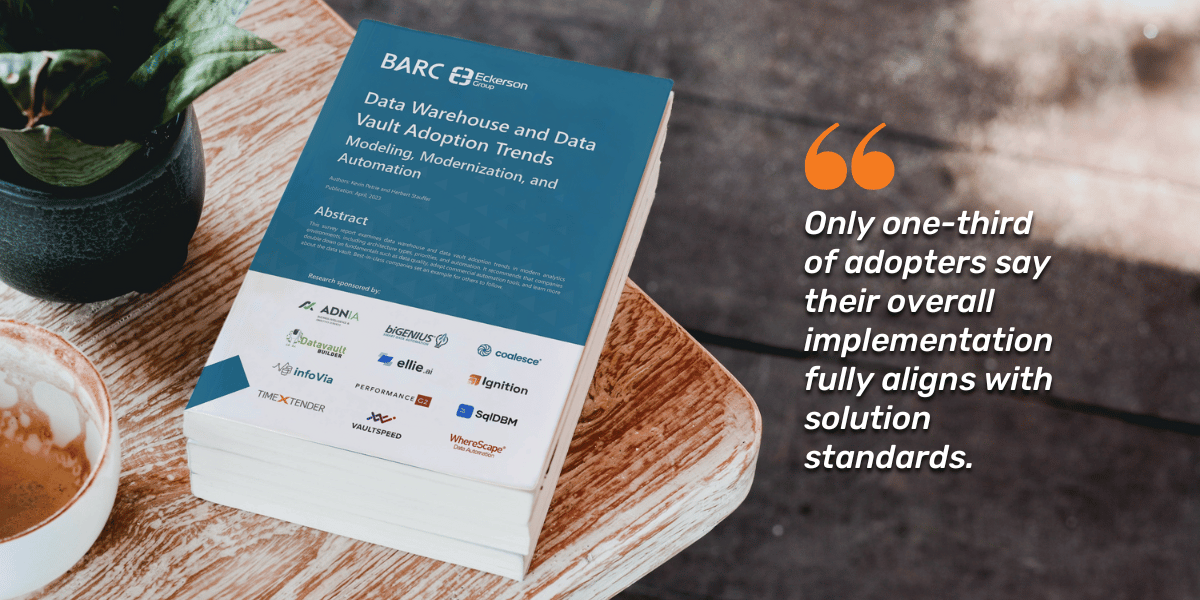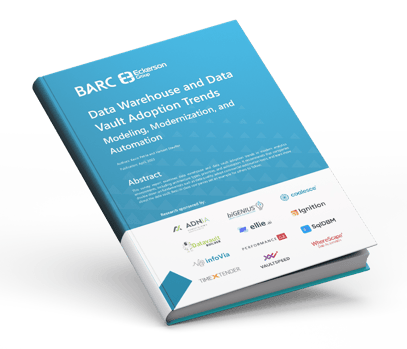3 min read
Get FREE Access to BARC's New Report: The State of the Data Vault
Written by: Micah Horner, Product Marketing Manager, TimeXtender - May 1, 2023

A recent report titled "Data Warehouse and Data Vault Adoption Trends: Modeling, Modernization, and Automation" sheds light on the current landscape of data management and analytics, particularly the role of the Data Vault.
Eckerson Group wrote this report in collaboration with BARC by studying the results of a global survey of 238 data & analytics practitioners and leaders. BARC conducted the survey in December 2022 and January 2023, drawing respondents from companies of various sizes and across various industries.
This report makes clear that, as businesses continue to generate and rely on vast amounts of data, understanding Data Vault in the context of modern analytics environments is crucial for success.
What Is Data Vault?
Data Vault is a modern data modeling and storage methodology designed to address the ever-growing challenges of data management in today's complex and rapidly changing business environments. Conceived by Dan Linstedt, Data Vault is built upon three core principles: flexibility, scalability, and adaptability.
The Data Vault model consists of three primary components: Hubs, Links, and Satellites. Hubs represent unique business entities, such as customers or products, and store their business keys. Links connect Hubs, capturing the relationships between these business entities. Satellites store the descriptive attributes and historical data associated with Hubs and Links.
One of the key strengths of Data Vault is its ability to accommodate changes in business requirements, data sources, and data structures with minimal impact on the existing data model. This agility makes it an attractive option for businesses facing evolving data needs and seeking a robust solution for managing their data warehouses.
The Pitfalls of the tool stack in Data Vault Implementation
A fragmented stack of tools, systems, and technologies can lead to a never-ending cycle of pain and frustration for organizations. These stacks emerge when companies attempt to address their growing data management needs by introducing new tools and platforms without fully replacing or integrating with their existing systems. This disconnected approach creates complexity, inefficiency, and increased maintenance costs.
These fragmented stack of tools are particularly detrimental to the successful implementation of Data Vault, as they can hinder the methodology's core benefits of flexibility, scalability, and adaptability. Moreover, they make it challenging for organizations to achieve and maintain data quality, which is a top priority for any organization.
The IMPORTANCE of automation for data vault success
Achieving data quality is a priority for any organization, regardless of the technique used, such as dimensional modeling by Kimball or Data Vault. Automation is particularly significant in Data Vault implementation, as it streamlines processes and ensures data quality throughout the data management lifecycle.
Automation also enhances the methodology's core benefits of flexibility, scalability, and adaptability. It simplifies the process of managing changes in business requirements, data sources, and data structures, reducing the impact on the existing data model.
Automated tools like TimeXtender help organizations avoid the pitfalls by providing a unified and efficient solution for data integration. By implementing automation tools instead of relying on homegrown scripts, organizations can improve data quality, standardize tasks, and facilitate reusability.
The SEMANTIC Layer as a key component
One of the challenges that business users face when querying a Data Vault model is its complexity. Even with a strong Data Catalog solution in place, it can still be difficult for non-technical users to access and analyze the data stored in a Data Vault model.
The ideal setup consists of a “Data Vault 2.0” model complemented by semantic layers for business-related areas. This combination creates a powerful, holistic solution that empowers users to derive insights and make data-driven decisions.
timextender's holistic approach to data integration
Recognizing the importance of an end-to-end combined offering, TimeXtender provides a comprehensive solution for data integration, including the implementation and management of Data Vault. By offering a holistic tool for data integration, TimeXtender eliminates the need for a fragmented stack of tools and ensures seamless, efficient data management.
With TimeXtender, organizations can leverage the benefits of Data Vault while avoiding the pitfalls of disconnected tools and technologies. By streamlining the data integration process and providing a unified solution for Data Vault implementation, TimeXtender enables organizations to maximize their data quality and analytics performance.
The addition of TimeXtender’s “Shared Semantic Layer” further enhances the value of Data Vault by creating a “Data Vault 2.0” approach with a user-friendly interface for business users to access and analyze data.
In conclusion, understanding Data Vault in the context of modern analytics environments is important for success in today's data-driven world. This new report highlights key insights and best practices for organizations considering Data Vault adoption.
By avoiding the pitfalls and embracing holistic automation tools like TimeXtender, organizations can successfully implement and manage Data Vault, ensuring data quality and effective analytics performance.
 Get FREE access to the report, "Data Warehouse and Data Vault Adoption Trends: Modeling, Modernization, and Automation.”
Get FREE access to the report, "Data Warehouse and Data Vault Adoption Trends: Modeling, Modernization, and Automation.”

